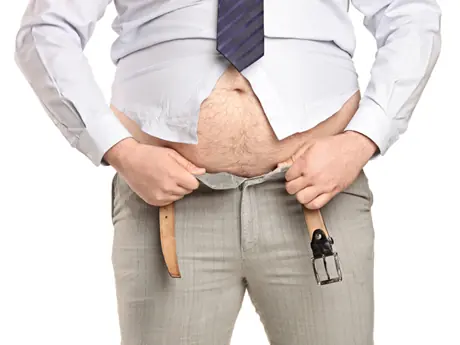
The man on the operating table is under IV sedation, facedown, circles drawn around the flabbiest parts of his body. He's painted with iodine and has two small holes punched through the soft skin of his lower back. Board-certified New York City plastic surgeon David Shafer, M.D., aligns the tip of a foot-long suction wand, called a cannula, with one of the holes. He carefully places it beneath the skin. It makes a slurping sound like a straw sucking at the bottom of a milkshake.
For the next hour, Dr. Shafer will be hoovering adipose fat cells from the man's back, flanks, and stomach.
This is where men tend to collect the most fat, explains Dr. Shafer—above the waist and over the ab muscles. He reaches down to grab a handful of the loose flab on the man's torso. "This is what we call subcutaneous fat," he says. It's the soft stuff you feel when you pinch your own belly.
Then Dr. Shafer sweeps his hand across the patient's midsection, the soft cavity containing the intestines, kidneys, and liver. "And see how the gut swells outward? That's the visceral fat pushing from beneath the rectus muscles."
That's the dangerous stuff.
More: What's the Big Fat Deal? Basic Facts on Fat
When researchers in St. Louis tracked a group of liposuction patients after surgery, they found zero improvement in blood pressure, triglycerides, glucose tolerance, or HDL or LDL cholesterol profiles. The pale, gloppy fat that a patient pays to have removed isn't pretty, but its absence doesn't guarantee the health profile of a lean, fit person.
That's because visceral fat, the kind that wraps around your organs and makes you unhealthy, is also the kind that liposuction can't reach. "There's no safe way to suck around the heart, kidney, and liver," says Dr. Shafer. "It's just too dangerous."
The more researchers learn about body fat, the more they've come to view it as a multi-faceted substance. In a sense, it's not unlike the fat in food. The artery-clogging trans fat in partially hydrogenated margarine isn't the same as the heart-healthy monounsaturated fat in olive oil, right? Well, neither is the fat around your quads the same as the fat around your liver. In terms of its impact on your health, the amount of fat your body carries is less important than where your body stores it."It's still not completely understood, but fat behaves very differently on different parts of the body," says Dr. Shafer.
More: Build Your Core With Nutrition
The better your grasp of this concept, the better you'll understand the need to target your body's most dangerous fat.
Hidden Fat Fact 1
Body fat saved your ancestors.
Say you're a hungry caveman plodding along the tundra and you spot a 6-ton woolly mammoth wandering on the horizon. You want an energy source that kicks into action immediately so you can chase and kill the beast. That's very likely the reason men store more upper-body fat than women do, says Fredrik Karpe, M.D., Ph.D., a professor of metabolic medicine at the University of Oxford. Men were the hunters.
"Upper-body fat, including visceral fat, is a kind of fight-and-flight depot that both stores and releases energy very easily," he says.
It does this through a process called lipolysis, which breaks clumps of fat into fatty acids that your muscles can use as energy. In visceral fat, lipolysis occurs at an unusually high rate. It's an ongoing process of deconstruction and reconstruction that keeps your bloodstream flooded with fat. This high concentration of fat compounds can bog down your liver and jack up LDL cholesterol and triglyceride levels.
More: 8 Nutrition Tips for a Healthy Heart
The big problem today is that our bodies still hold on to visceral fat even though we're no longer starving cavemen. "Those fat depots are no longer useful," says Dr. Karpe. "It comes at a price to have such easily mobilized fat."
But regular exercise can help neutralize those cardiovascular risks, says Dr. Karpe. When you put your muscles to work, they release enzymes that pluck circulating triglycerides from the blood and burn them off as fuel, which can help clear danger from your arteries.
- 1
- of
- 3








Discuss This Article